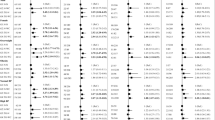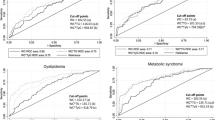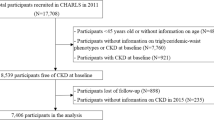Abstract
Aim:
To study the prevalence of hypertriglyceridemic waist (HTGW) in an urban adult Spanish population and its association with type 2 diabetes mellitus (T2DM) and cardiovascular disease (CVD).
Methods:
We undertook a cross-sectional analysis in a random sample of 2270 individuals (18–80 years of age). All participants provided a clinical history and underwent a physical examination. Blood and urine analyses were conducted. HTGW was diagnosed using anthropometric criteria for the European population (waist circumference: for men, ⩾94 cm; for women, ⩾80 cm) and fasting plasma triglycerides (TGs) ⩾1.71 mmol l−1 (⩾150 mg per 100 ml).
Results:
The prevalence of HTGW was 14.5% (men: 18.2%, women: 10.8%) and was significantly greater in men <59 years (P<0.001). HTGW was associated with older individuals, a low educational level and, in men, with a sedentary lifestyle (P<0.001). Subjects with HTGW had higher levels of total cholesterol, low-density lipoprotein-cholesterol (LDL-c) and uric acid, lower levels of high-density lipoprotein-cholesterol, a higher blood pressure, a greater degree of obesity and a higher prevalence of T2DM (20.00 vs 6.4%, P<0.001) (odds ratio (OR) 3.61; 95% confidence interval (95% CI), 2.60–5.01) and CVD (8.5 vs 3.4%, P<0.001) (OR 2.63; 95% CI, 1.66–4.16). The association of HTGW with T2DM and CVD disappeared after adjusting for age. The degree of concordance between HTGW and the metabolic syndrome (MS) was moderate, with both the Adult Treatment Panel III Report (ATP-III) and the International Diabetes Federation criteria (κ=0.51 and κ=0.58, respectively). Subjects with isolated HTGW as compared with those with isolated MS (ATP-III) were younger, had greater levels of total cholesterol, LDL-c and TGs and a lower prevalence of obesity, high blood pressure and dysglycemia.
Conclusion:
HTGW is a phenotype of cardiometabolic risk prevalent in the adult population in our environment. HTGW may be an alternative to MS to detect the population at risk for T2DM and CVD, especially in young individuals who do not fulfill the criteria for MS.
This is a preview of subscription content, access via your institution
Access options
Subscribe to this journal
Receive 12 print issues and online access
$259.00 per year
only $21.58 per issue
Buy this article
- Purchase on Springer Link
- Instant access to full article PDF
Prices may be subject to local taxes which are calculated during checkout

Similar content being viewed by others
References
Després JP, Lemieux I, Bergeron J, Pibarot P, Mathieu P, Larose E et al. Abdominal obesity and the metabolic syndrome: contribution to global cardiometabolic risk. Arterioscler Thromb Vasc Biol 2008; 28: 1039–1049.
Couillard C, Bergeron N, Prud’homme D, Bergeron J, Tremblay A, Bouchard C et al. Postprandial triglyceride response in visceral obesity in men. Diabetes 1998; 47: 953–960.
Pouliot MC, Despres JP, Lemieux S, Moorjani S, Bouchard C, Tremblay A et al. Waist circumference and abdominal sagittal diameter: best simple anthropometric indexes of abdominal visceral adipose tissue accumulation and related cardiovascular risk in men and women. Am J Cardiol 1994; 73: 460–468.
Wang J, Thornton JC, Bari S, Williamson B, Gallagher D, Heymsfield SB et al. Comparisons of waist circumferences measured at 4 sites. Am J Clin Nutr 2003; 77: 379–384.
Wang J . Waist circumference: a simple, inexpensive, and reliable tool that should be included as part of physical examinations in the doctor's office. Am J Clin Nutr 2003; 78: 902–903.
Cheal KL, Abbasi F, Lamendola C, McLaughlin T, Reaven GM, Ford ES . Relationship to insulin resistance of the Adult Treatment Panel III diagnostic criteria for identification of the metabolic syndrome. Diabetes 2004; 53: 1195–1200.
Liao Y, Kwon S, Shaughnessy S, Wallace P, Hutto A, Jenkins AJ et al. Critical evaluation of Adult Treatment Panel III criteria in identifying insulin resistance with dyslipidemia. Diabetes Care 2004; 27: 978–983.
Carr DB, Utzschneider KM, Hull RL, Kodama K, Retzlaff BM, Brunzell JD et al. Intra-abdominal fat is a major determinant of the National Cholesterol Education Program Adult Treatment Panel III criteria for the metabolic syndrome. Diabetes 2004; 53: 2087–2094.
Hanley AJ, Williams K, Stern MP, Haffner SM . Homeostasis model assessment of insulin resistance in relation to the incidence of cardiovascular disease: the San Antonio heart study. Diabetes Care 2002; 25: 1177–1184.
Tankó LB, Bruun JM, Alexandersen P, Bagger YZ, Richelsen B, Christiansen C et al. Novel associations between bioavailable estradiol and adipokines in elderly women with different phenotypes of obesity: implications for atherogenesis. Circulation 2004; 110: 2246–2252.
Kahn HS, Valdez R . Metabolic risks identified by the combination of enlarged waist and elevated triacylglycerol concentration. Am J Clin Nutr 2003; 78: 928–934.
Grundy SM, Brewer HB, Cleeman JI, Smith SC, Lenfant C, For the Conference Participants. Definition of metabolic syndrome. Report of the National Heart, Lung, and Blood Institute/American Heart Association Conference on Scientific Issues Related to Definition. Circulation 2004; 109: 433–438.
Alberti KG, Zimmet P, Shaw J, IDF Epidemiology Task Force Consensus Group. The metabolic syndrome—a new worldwide definition. Lancet 2005; 366: 1059–1062.
The International Expert Committee. International Expert Committee Report on the Role of the A1C Assay in the Diagnosis of Diabetes. Diabetes Care 2009; 32: 1–8.
World Health Organization. Obesity: Preventing and Managing the Global Epidemic: Report on a WHO Consultation (WHO Technical Report Series 894). World Health Organization: Geneva, Switzerland, 2000.
Lemieux I, Alméras N, Mauriége P, Blanchet C, Dewailly E, Bergeron J et al. Prevalence of ‘hypertriglyceridemic waist’ in men who participated in the Quebec Health Survey: association with atherogenic and diabetogenic metabolic risk factors. Can J Cardiol 2002; 18: 725–732.
LaMonte MJ, Ainsworth BE, DuBose KD, Grandjean PW, Davis PG, Yanowitz FG et al. The hypertriglyceridemic waist phenotype among women. Atherosclerosis 2003; 171: 123–130.
Bos G, Dekker JM, Heine RJ . Non-HDL cholesterol contributes to the ‘hypertriglyceridemic waist’ as a cardiovascular risk factor. The Hoorn Study. Diabetes Care 2004; 27: 283–284.
Solati M, Ghanbarian A, Rahmani M, Sarbazi N, Allahverdian S, Azizi F . Cardiovascular risk factors in males with hypertriglycemic waist (Tehran Lipid and Glucose Study). Int J Obes Relat Metab Disord 2004; 28: 706–709.
Tankó LB, Bagger YZ, Qin G, Alexandersen P, Larsen PJ, Christiansen C . Enlarged waist combined with elevated triglycerides is a strong predictor of accelerated atherogenesis and related cardiovascular mortality in postmenopausal women. Circulation 2005; 111: 1883–1890.
Czernichow S, Bruckert E, Bertrais S, Galan P, Hercberg S, Oppert JM . Hypertriglyceridemic waist and 7.5-year prospective risk of cardiovascular disease in asymptomatic middle-aged men. Int J Obes (Lond) 2007; 31: 791–796.
Lemieux I, Pascot A, Couillard C, Lamarche B, Tchernof A, Almeras N et al. Hypertriglyceridemic waist: a marker of the atherogenic metabolic triad (hyperinsulinemia; hyperapolipoprotein B; small, dense LDL) in men? Circulation 2000; 102: 179–184.
Lamarche B, Tchernof A, Moorjani S, Cantin B, Dagenais GR, Lupien PJ et al. Small, dense low-density lipoprotein particles as a predictor of the risk of ischemic heart disease in men: prospective results from the Québec Cardiovascular Study. Circulation 1997; 95: 69–75.
St-Pierre J, Lemieux I, Perron P, Brisson D, Santuré M, Vohl MC et al. Relation of the ‘hypertriglyceridemic waist’ phenotype to earlier manifestations of coronary artery disease in patients with glucose intolerance and type 2 diabetes mellitus. Am J Cardiol 2007; 99: 369–373.
Onat A, Ayhan E, Hergenç G, Can G, Barlan MM . Smoking inhibits visceral fat accumulation in Turkish women: relation of visceral fat and body fat mass to atherogenic dyslipidemia, inflammatory markers, insulin resistance, and blood pressure. Metabolism 2009; 58: 963–970.
Lamarche B, Tchernof A, Mauriége P, Cantin B, Dagenais GR, Lupien PJ et al. Fasting insulin and apolipoprotein B levels and low-density lipoprotein particle size as risk factors for ischemic heart disease. JAMA 1998; 279: 1955–1961.
Blackburn P, Lamarche B, Couillard C, Pascot A, Bergeron N, Prud’homme D et al. Postprandial hyperlipidemia: another correlate of the ‘hypertriglyceridemic waist’ phenotype in men. Atherosclerosis 2003; 171: 327–336.
St-Pierre J, Lemieux I, Vohl MC, Perron P, Tremblay G, Despres JP et al. Contribution of abdominal obesity and hypertriglyceridemia to impaired fasting glucose and coronary artery disease. Am J Cardiol 2002; 90: 15–18.
Sam S, Haffner S, Davidson MH, D Agostino RB, Feinstein S, Kondos G et al. Hypertriglyceridemic waist phenotype predicts increased visceral fat in subjects with type 2 diabetes. Diabetes Care 2009; 32: 1916–1920.
Gazi IF, Filippatos TD, Tsimihodimos V, Saougos VG, Liberopoulos EN, Mikhailidis DP et al. The hypertriglyceridemic waist phenotype is a predictor of elevated levels of small, dense LDL cholesterol. Lipids 2006; 41: 647–654.
World Health Organization. WHO Statistical Information System (WHOSIS). [Consulted in August 2009]. http://www3.who.int/whosis/.
Instituto Nacional de Estadística. INEbase [consulted in August 2009]. Available at: http://www.ine.es/inebase/.
Basterra-Gortari FJ, Bes-Rastrollo M, Seguí-Gómez M, Forga L, Alfredo-Martínez J, Martínez-González MA . Tendencias de la obesidad, diabetes mellitus, hipertensión e hipercolesterolemia en España (1997–2003). Med Clin (Barc) 2007; 129: 405–408.
Acknowledgements
We thank Rita Perez González (Imabis Foundation) for her collaboration, and the doctors and nurses of ‘Ciudad Jardin’ Health Center who participated in the IMAP study: Antón Cortés M, Fernández Tapia ML, Ginel Mendoza L, Kuhn González M, Linares Castro L, Martos Cerezuela I, Mestre Reoyo G, Muñoz Villalba JC, Paniagua Gómez F, Pérez Juncosa F, Reyes Alcázar P, Rodríguez Lago JA, Rodríguez Rivera MR, Sánchez Pérez R, Sacristán Visquert E, Taboada González F. CIBER de Obesidad y Nutrición and CIBER de Diabetes y Enfermedades Metabólicas Asociadas are ISCIII projects. This study was undertaken with finance from the Consejería de Salud de la Junta de Andalucía (no. exp.283/06), Consejería de Innovación de la Junta de Andalucía (CTS 04369) and Fondo de Investigación Sanitaria (PS09/00997).
Author information
Authors and Affiliations
Corresponding author
Ethics declarations
Competing interests
The authors declare no conflict of interest.
Rights and permissions
About this article
Cite this article
Gomez-Huelgas, R., Bernal-López, M., Villalobos, A. et al. Hypertriglyceridemic waist: an alternative to the metabolic syndrome? Results of the IMAP Study (multidisciplinary intervention in primary care). Int J Obes 35, 292–299 (2011). https://doi.org/10.1038/ijo.2010.127
Received:
Revised:
Accepted:
Published:
Issue Date:
DOI: https://doi.org/10.1038/ijo.2010.127
Keywords
This article is cited by
-
Association between hypertriglyceridemic-waist phenotype and circadian syndrome risk: a longitudinal cohort study
Hormones (2023)
-
Association between hypertriglyceridemic-waist phenotype and non-alcoholic fatty liver disease: a general population-based study
Lipids in Health and Disease (2022)
-
Association of hypertriglyceridemic waist phenotype with non-alcoholic fatty liver disease: a cross-sectional study in a Chinese population
Hormones (2022)
-
Identification of metabolic syndrome using phenotypes consisting of triglyceride levels with anthropometric indices in Korean adults
BMC Endocrine Disorders (2020)
-
Cutoff point estimation for serum vitamin D concentrations to predict cardiometabolic risk in Brazilian children
European Journal of Clinical Nutrition (2020)



